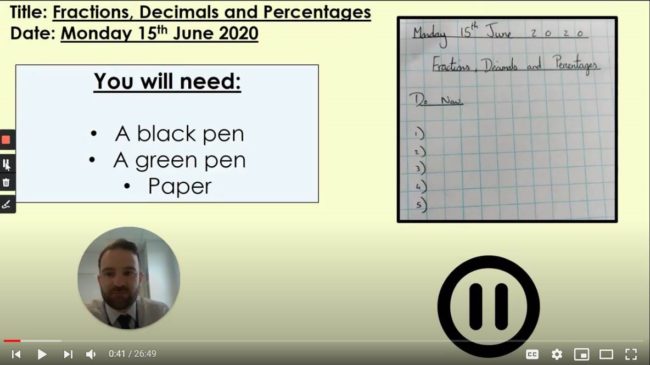06.18.20‘The Level 2 Video’ & Other Lessons from Chloe Hykin & Her Colleagues at Marine Academy Plymouth

I’m happy to post another really useful example of a video with some good ideas for online instruction.
This one comes from Chloe Hykin and her colleagues at Marine Academy Plymouth, in Plymouth, England.
The opening of Chloe’s asynchronous lesson is a really well executed example of some things we’ve been describing on this blog:
Warm, face visible greeting that actively tries to ‘dissolve the screen’–connect with students around the work. This segues into an energetic and engaging demeanor.
Excellent use of a clear and helpful ‘materials screen’ to help students prepare consistently for class (and to allow their parents to help more too). Glory points to Chloe for adding a hand-written example of what the student’s hand written note page should look like. Just the other day we were discussing this at TLAC Towers… how we often say “make your paper look like mine” but “mine” is a PPT slide. Chloe really can use that phrase! We also loved the way Chloe planned out where her own face would be on the screen so she can point to the various places where models are found on the screen.
Finally her slides do a really nice job of sharing and organizing what’s important without including extraneous and distracting materials. This is one of the key points Daisy Christodoulou makes in her new book.
But there were other things we liked about Chloe’s lesson and they were things we haven’t seen as often. The thing we liked best perhaps was the mention she makes several times of a level two video. Chloe is constantly pushing her students to self-assess and to not be afraid to calmly acknowledge, yes I’m struggling. I mean, why not when there’s a handy review video that Mr. Hamer has produced that they can go watch.
We’ve written here about implicit accountability–socializing students to self-assess against a model during online instruction. It’s both a necessity–in asynchronous instruction–and an opportunity–to perhaps build student ownership of the learning process. But offering a real concrete action students can take to solve the problem–there are move videos; it’s just a matter of your choosing to use them–takes it to a new level. For now I’m going to call this idea of embedding contingency and choice in asynchronous video CYOA [i.e. Choose Your Own Adventure]
There are five warm-up questions for students to start with. Chloe does just ask students to do them but she’s actively building culture… “I want to see you having a go at every question, pushing yourself at the extension when you finish,” she says. Message: The quality of your effort online matters to me. There is a difference between done barely and done well.
We’ve written previously about “Pause Points” as well. They help you to make asynchronous lessons interactive. But the risk is the roll-through. Students either accidentally roll through the pause and fail to do the work or they deliberately do so because, well, I would have too at 14.
Anyway Chloe’s videos–and the rest of the videos her colleagues at Marine Academy Plymouth have produced–think carefully about this problem. There’s a bright clear reminder to “Press pause and have a go at your Do Now” but you’ll also notice that she often leaves a real time pause in there… she extends the dead time as a tacit reminder to students that they should be pausing. It’s like watching newscasters during a commercial break. It snaps you to attention a bit. And for kids who are slow to respond., well, they’re less likely to roll through by accident.
Also love the expectations expressed in the answer reveal: ‘ticking your answers there for me.’ Again, she’s doing everything she can to socialize follow-through and active engagement from her pupils.
Here’s a bit more of the opening from Chloe’s lesson:
Her discussion of the objective is nice in three ways. 1. She expresses genuine excitement for it and for the fact that it’s challenging. The good part is that it’s difficult. Cue Carol Dweck. 2. She reminds students about the resource video they can go to if they struggle. 3. She moves fast and is impeccably planned but like Joshua Humphrey not so planned that she sounds scripted. It’s warm and engaging but purposeful and we get to work quickly.
Finally we loved the fact that the lesson started with retrieval practice. It’s doubly important in an online environment where student attention can be hard to sustain to make sure learning is embedded in long-term memory and that key background knowledge is activated before a lesson. And of course there’s a great reminder–the third one so far!–that the level two video is there for students if they need it. It’s the most normal thing in the world.
Last note. Here’s a screen shot of her colleague Mr Hamer, he of the level two lesson. What do you notice?

Yup, me too! Absolute consistency. For a student who does decide to go back and forth between teachers nothing could be simpler because the visual environment and learning procedures are exactly the same.
Thanks to Chloe and everyone at Marine Academy Plymouth. They have a TON more great videos you can watch here: https://www.youtube.com/playlist?list=PLc1Uh-Lm7CtoKE1c6NcqlKF8k5kKIC9Sr and their work is a real gift for teachers so I hope you’ll check it out.
